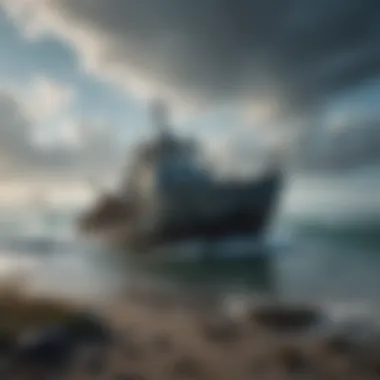Ocean Pollution: Impacts, Sources, and Solutions


Intro
Ocean pollution is a pressing environmental issue that affects not only marine life but also human health and the global economy. Contaminants from various sources accumulate in the oceans, leading to dire consequences for ecosystems and communities that rely on these waters. Understanding the origins, types, and impacts of ocean pollution is essential for developing effective solutions and policies. This inspection aims to shed light on specific threats posed by pollutants, the socio-economic factors involved, and the strategies necessary to combat this problem.
Marine pollution can stem from multiple sources. Plastics, chemicals, and nitrates are among the most concerning types of pollutants. Each type has unique pathways and has different impacts on the environment and health. This complexity demands a multifaceted approach to mitigation. Given the interconnectedness of global ecosystems, collaborative international efforts are imperative. Hence, a comprehensive understanding of ocean pollution is necessary for everyone—from students to professionals—to foster sustainable practices and advocate for robust policy frameworks.
The following sections will delve deeper into these topics, providing a clearer picture of the state of our oceans and the challenges we face.
Research Overview
Summary of Key Findings
Recent studies reveal alarming statistics regarding ocean pollution levels. For example, researchers estimate that about eight million tons of plastic waste enter the oceans each year. This issue not only leads to the degradation of marine ecosystems but also poses health risks to humans through the consumption of contaminated seafood. Additionally, pollution from agricultural runoff contributes significantly to nutrient loading, resulting in harmful algal blooms that further disrupt marine balance.
Relevance to Current Scientific Discussions
Ocean pollution is becoming an increasingly critical point in scientific discourse. There are discussions about the impacts of microplastics on marine life and human health. Studies also explore the economic implications, particularly in communities heavily reliant on fishing and tourism. As more evidence emerges, the urgency to address these challenges prompts new discussions around policy changes and preventive measures.
Methodology
Research Design and Approach
The examination of ocean pollution draws on a variety of research methodologies. Comparative studies are often used to analyze pollution levels across different regions. This involves reviewing historical data and current statistics to assess trends in ocean health.
Data Collection and Analysis Techniques
Data is typically sourced from research institutions, governmental organizations, and environmental agencies. Various measures include field studies, laboratory analyses, and satellite imagery. This multi-pronged approach allows for a more comprehensive understanding of pollution patterns and impacts, leading to more informed recommendations for action.
Understanding Ocean Pollution
Ocean pollution is a pressing global issue that poses significant risks not only to marine ecosystems but also to human well-being. Understanding ocean pollution entails not just grasping the various forms it takes but also recognizing its implications on a broader scale. The ocean, covering over 70% of the Earth's surface, functions as a vital resource for food, climate regulation, and economic activities. However, pollution disrupts these functions and threatens the balance of life within oceanic systems.
Definition and Scope
Ocean pollution refers to the introduction of harmful substances or contaminants into the marine environment. These can include a variety of pollutants, such as plastics, chemicals, and nutrients, that stem from both land-based and marine sources. The scope of ocean pollution extends beyond visible debris; it encompasses microplastics and toxic chemicals that infiltrate even the most remote areas of the ocean. Understanding the definition and scope is crucial for addressing the challenges ocean pollution presents.
Historical Perspective
The history of ocean pollution can be traced back centuries, but dramatic increases have occurred in recent decades due to industrialization and urbanization. Initially, waste dumping and oil spills marked major pollution events, highlighting the oceans' vulnerability. However, the rise of plastic production in the mid-20th century significantly changed the landscape. Today, billions of tons of waste enter the ocean annually. Historical analysis reveals that the response to these violations has also evolved, showcasing both failures and successes in policy and public awareness.
"The ocean is a silent witness to humanity’s negligence, and understanding its condition is a first step to restoration."
By comprehensively understanding ocean pollution, its definition, and its historical context, researchers and policymakers can better devise effective strategies for remediation and prevention.
Types of Pollutants in the Ocean
Understanding the types of pollutants in the ocean is vital for assessing the health of marine ecosystems. Different pollutants have varied sources and effects. Each pollutant poses unique challenges and requires targeted approaches for mitigation. Examining these pollutants offers insights into the necessary actions needed to reduce their impact on both marine and human life.
Plastic Debris
Plastic debris is a pervasive pollutant found in oceans worldwide. It encompasses a range of materials, including single-use plastics and microplastics. One key aspect of plastic debris is its durability; it does not decompose easily. This can lead to long-term environmental concerns as plastics persist in marine habitats.
Moreover, plastic pollution can harm marine organisms through ingestion and entanglement. Sea turtles, for example, often mistake plastic bags for jellyfish. This not only affects animal health but can also disrupt marine food webs. Reducing single-use plastics and enhancing waste management are crucial steps to address this pollutant.
Chemical Contaminants
Chemical contaminants in oceans can severely threaten marine ecosystems. They often originate from agricultural runoff, industrial waste, and urban development.
Pesticides
Pesticides represent a considerable subset of chemical contaminants. Their use is widespread in agriculture to protect crops from pests. However, when these chemicals enter waterways, they can become toxic to marine life. One notable feature of pesticides is their ability to bioaccumulate. This means they can build up in organisms, affecting not just the immediate wildlife but also those who consume them. Understanding the life cycle and persistence of pesticides helps in developing strategies to mitigate their effects in the sea.
Heavy Metals
Heavy metals like mercury and lead are hazardous pollutants found in ocean waters. They often stem from industrial activities and atmospheric deposition. The key characteristic of heavy metals is their toxicity, even at low concentrations. They can adversely affect the nervous systems of fish and other marine animals. A significant point is their long-lasting nature, as heavy metals do not degrade. Thus, contamination can persist for years, complicating cleanup and restoration efforts. It is essential to monitor and regulate sources to minimize their entry into marine environments.


Pharmaceuticals
Pharmaceuticals in oceans mainly result from human consumption and improper disposal. They encompass a wide variety of substances, ranging from painkillers to antibiotics. A critical aspect of pharmaceuticals is their impact on aquatic organisms, which may react to these chemicals differently. Their presence in water bodies may lead to disrupted reproductive processes in fish and other aquatic species. Addressing this pollution source involves improving disposal methods and enhancing wastewater treatment processes to filter out these substances before they enter the ocean.
Nutrient Pollution
Nutrient pollution is often overlooked but can cause severe ecological ramifications in the ocean. A rise in nutrients, particularly nitrogen and phosphorus, leads to several issues.
Eutrophication
Eutrophication occurs when excessive nutrients stimulate algal blooms. These blooms can deplete oxygen in the water, leading to dead zones where aquatic life cannot survive. The key characteristic of eutrophication is its potential for rapid and destructive changes in ecosystem dynamics. For conservation efforts, understanding the triggers of eutrophication is crucial for preventing its onset.
Impact on Oxygen Levels
The impact on oxygen levels is another significant concern linked to nutrient pollution. As algae die and decay, dissolved oxygen is consumed in the process, leading to anoxic conditions. This, in turn, affects the diversity of marine life, as species that rely on oxygen-rich waters struggle to thrive. Monitoring oxygen levels in ocean bodies can inform broader management strategies to maintain marine biodiversity.
Sources of Ocean Pollution
Understanding the sources of ocean pollution is crucial for addressing this pressing issue. This section outlines the various origins of pollutants and how they contribute to the degradation of marine ecosystems. Land-based sources, marine-based sources, and atmospheric deposition all play significant roles in this phenomenon. Grasping these sources allows for more effective strategies in management and pollution reduction.
Land-Based Sources
Industrial Discharges
Industrial discharges represent a major factor in ocean pollution. These are the wastes and byproducts released by factories, often containing harmful chemicals. A key characteristic of industrial discharges is their volume; they can be substantial when considering modern manufacturing processes. It is a popular topic for scrutiny because these discharges can lead to water toxicities that affect marine life and human health. A unique feature of industrial discharges is their complex composition, which can include heavy metals, solvents, and organic compounds.
The advantages of highlighting industrial discharges in this article include better awareness and comprehension of their regulatory needs, facilitating improvements in treatment and prevention practices. However, the disadvantages can include significant costs for industries to comply with stricter regulations.
Urban Runoff
Urban runoff is another significant source of ocean pollutants. This occurs when rainwater flows over urban surfaces, collecting various contaminants along the way. A hallmark of urban runoff is its ability to carry a wide range of pollutants, including oils, heavy metals, and debris, straight into the ocean. This aspect makes it an essential focus for this article, as it impacts coastal water quality dramatically. Urban communities often lack adequate infrastructure for stormwater management, making runoff a critical topic. The unique features of urban runoff include its unpredictability and its reliance on weather patterns. The advantages of addressing urban runoff include improving water treatment technologies, while the disadvantages often entail the challenge of updating urban infrastructure to manage stormwater effectively.
Marine-Based Sources
Shipping and Navigation
Shipping and navigation activities also contribute significantly to ocean pollution. This aspect covers the waste materials generated by vessels, including oil spills, ballast water discharge, and sewage. A key characteristic of this source is the vast scale of maritime operations, which elevate its pollution potential. Its recognition is vital due to the increasing volume of global trade.
A unique feature of shipping is that it can cause immediate and catastrophic impacts on localized marine environments via spills. The advantages of including shipping in our discussion focus on the potential for stricter pollution control measures, while the downside often involves the enforcement challenges across international waters.
Offshore Drilling
Offshore drilling is another major marine-based source of pollution. This practice entails extracting oil and gas from beneath the ocean floor, and it poses a significant risk to marine ecosystems. A key characteristic of offshore drilling is the potential for accidents, such as blowouts and spills. This topic holds importance within the article due to the potential for widespread environmental damage associated with drilling operations.
Drilling operations are often situated in delicate ecosystems, which increases the stakes of any pollution event. The advantages of addressing offshore drilling involve increased scrutiny and improved safety protocols. However, the disadvantages include resistance from industries that depend heavily on fossil fuels for economic stability.
Atmospheric Deposition
Atmospheric deposition refers to pollutants settling into the ocean from the air. This can occur through processes such as rain, dust, or gas exchange. This phenomenon is significant as it represents a pathway for terrestrial pollutants to affect marine systems. A key characteristic of atmospheric deposition is its long-range transport of pollutants, which can come from far inland or even other countries. The inclusion of this topic in the article is beneficial as it emphasizes the interconnectedness of environmental issues across different regions. Unique features of atmospheric deposition include its influence by climate conditions, affecting deposition rates and types of pollutants transferred. However, the challenge lies in tracking these pollutants and establishing accountability, which can complicate management efforts.
Understanding the sources of ocean pollution enables targeted actions and policies, essential for mitigating its impacts effectively.
Impacts of Ocean Pollution
The examination of ocean pollution is crucial, as its effects ripple through marine ecosystems, human health, and economies. Understanding these impacts helps us recognize the extent of the crisis and guides the development of effective solutions. Ocean pollution, including plastics, chemicals, and nutrient runoff, has far-reaching consequences that necessitate immediate attention and action.
Effects on Marine Life
Marine organisms are significantly affected by ocean pollution. Their survival is tied to the health of their environments, and polluted oceans disrupt natural processes.
Trophic Level Disruption
Trophic level disruption occurs when pollutants alter the food chain. This can cause a cascade of effects, leading to population imbalances and reduced biodiversity. A key characteristic of trophic disruption is its ability to affect multiple species at different levels of the ecosystem. Such disruption is a popular topic in this article because it highlights the interconnectedness of marine life. The unique feature of this process is that it can lead to the decline of predator species when their prey becomes scarce, resulting in further ecological decline. The disadvantages of trophic level disruption include the potential for extinction of species and loss of marine life diversity.
Habitat Destruction
Habitat destruction refers to the degradation of marine environments, caused by pollutants like plastics and chemicals. This destruction contributes to the overall decline in marine health and is essential to discuss for its direct effects on biodiversity. The key characteristic of habitat destruction is its irreversible impact on ecosystems, especially sensitive areas such as coral reefs. This article emphasizes habitat destruction because it underlines the long-term consequences of pollution. Unique aspects include loss of shelters for aquatic life and impeded reproduction for numerous species. The disadvantages involve economic consequences and loss of recreational areas.
Implications for Human Health
Ocean pollution also poses direct threats to human health. Contaminated water and seafood introduce toxins into our diets, with severe health implications.


Contaminated Seafood
Contaminated seafood is a critical concern stemming from ocean pollution. Pollutants accumulate in fish and shellfish, which humans consume. A defining characteristic of this issue is the bioaccumulation of toxins, leading to potential health risks. This topic is essential as it directly ties ocean welfare to human safety. Unique elements include the types of contaminants found, such as heavy metals and microplastics. Advantages of understanding this issue involve raising awareness about food choices and promoting safer fishing practices.
Toxic Exposure
Toxic exposure occurs when humans come into contact with pollutants through water or airborne particles. This has significant health risks, such as neurological damage or cancer. A key characteristic of toxic exposure is its invisible nature, making it a serious concern for public health. Discussing this in the article raises awareness about the need for regulatory changes. Unique features include varying exposure levels depending on geographic location and lifestyle choices. The primary disadvantage is the rising health care costs associated with pollution-related illnesses.
Economic Consequences
The economic impact of ocean pollution is another vital aspect. It affects local and global economies, particularly those reliant on marine resources.
Fisheries Decline
Fisheries decline is directly linked to the health of marine ecosystems. Overfishing, paired with pollution, leads to a reduction in fish stocks. It is essential to discuss this aspect as it affects food security worldwide. The key characteristic of fisheries decline is its ripple effect on local economies and communities whose livelihoods depend on fishing. Highlighting this provides insight into the broader economic impacts of pollution. Unique features include changes in fishing regulations as stock levels dwindle. The disadvantages include loss of income for fishermen and increased food prices for consumers.
Tourism Impacts
Tourism impacts drive home the importance of ocean health. Many regions depend on clean beaches and vibrant marine life to attract visitors. Discussing this topic is crucial as it links ocean health to economic vitality. A key characteristic of tourism impacts is the direct correlation between environmental health and tourist influx. This article emphasizes tourism impacts to illustrate the economic stakes involved. Unique aspects include potential long-term damage to local economies if pollution continues to rise. The disadvantages include loss of jobs in the tourism sector and negative public perception of polluted areas.
Understanding the impacts of ocean pollution is not just an environmental concern but also a pressing human health and economic issue that demands our attention.
Mitigation Strategies
Mitigation strategies are essential to combatting ocean pollution. They provide frameworks and actions designed to reduce pollutants entering marine environments. These strategies not only target the sources of pollution but also aim to rehabilitate affected ecosystems. Successful mitigation can have considerable ecological, economic, and social benefits. Emphasis is placed on collaboration across various sectors, acknowledging that ocean pollution is a multifaceted issue requiring a collective approach.
Regulatory Approaches
International Treaties
International treaties are agreements between nations that address ocean pollution on a global scale. These treaties, such as the United Nations Convention on the Law of the Sea, help establish guidelines for how countries can manage their maritime activities, ensuring that pollution is minimized. A key characteristic of these treaties is their ability to unify participating countries toward a common goal. By providing a legal framework, they promote cooperation when dealing with marine ecosystems. However, a limitation of international treaties is their dependence on compliance and enforcement, which can vary by nation.
Local Legislation
Local legislation refers to laws enacted at the municipal, state, or national level to control pollution. These laws can directly target specific pollutants or establish standards for waste management. A notable characteristic of local legislation is its specificity, often tailored to the unique environmental needs of a locality. It can lead to immediate and observable changes and foster community engagement. Nevertheless, differences in resources and priorities can create challenges in enforcement and implementation.
Technological Innovations
Bioremediation
Bioremediation is a process that uses living organisms, primarily microorganisms, to degrade environmental pollutants and restore a balanced ecosystem. A significant advantage of bioremediation is its natural approach to cleaning, making it environmentally friendly. Bioremediation can be highly effective for specific types of pollutants, such as oil spills. However, the process often requires careful monitoring to ensure that it does not introduce new risks.
Advanced Filtration Systems
Advanced filtration systems are designed to remove contaminants from the water. These systems can filter microplastics, chemicals, and other pollutants before they enter marine environments. The key characteristic of these systems is their precision in targeting specific harmful substances. They represent a practical solution for industrial discharge and urban runoff issues. However, costs and maintenance can be barriers for widespread adoption, especially in less developed regions.
Community Involvement
Public Education
Public education is a pivotal component in engaging citizens to understand ocean pollution and its impacts. Informative campaigns can significantly raise awareness and encourage proactive behaviors among communities. A key characteristic of public education initiatives is their ability to motivate grassroots movements, which can have a rippling effect on policy. Despite its importance, reaching diverse audiences and addressing misinformation can be challenging.
Cleanup Initiatives
Cleanup initiatives are organized efforts to physically remove litter and pollutants from marine and coastal areas. These initiatives can involve volunteers and local organizations working together for environmental restoration. A fundamental aspect of cleanup initiatives is their visibility, which can inspire others to take action. However, while they can yield immediate results, these efforts may only serve as a temporary fix without complementary long-term strategies in place to reduce pollution at its source.
The Role of Research and Monitoring
Research and monitoring play crucial roles in addressing the challenges posed by ocean pollution. They allow for a more profound understanding of the extent and nature of pollution, facilitating the development of effective policies and strategies. Through carefully designed studies and innovative technologies, researchers gather data that reveals how pollutants affect various marine ecosystems and human health.
Moreover, monitoring efforts help track changes over time, enabling the evaluation of implemented solutions. Understanding this topic is essential to fostering a collaborative approach among scientists, policymakers, and the public. This section examines the methods of data collection and analysis, along with insightful case studies.
Data Collection and Analysis
Remote Sensing Technologies


Remote sensing technologies represent a significant advancement in oceanographic research. These tools utilize satellites and aerial sensors to collect data across vast ocean areas. They are particularly valuable for monitoring water quality and identifying pollution hotspots. A key characteristic of remote sensing is its ability to deliver real-time data, which is essential for timely responses to pollution events.
The unique feature of remote sensing is its capacity to cover large geographic areas with minimal effort. However, it may not provide in-depth local insights, which can be a limitation. Despite this, remote sensing remains a popular choice for its efficiency and the breadth of information it can deliver in environmental studies.
Field Studies
Field studies are equally important for a comprehensive understanding of ocean pollution. These studies involve direct observation and data collection from the ocean environment. Field studies provide a more nuanced view of pollution impacts on marine life and ecosystems. A major strength of field studies is their ability to capture complex interactions and specific ecological reactions to pollutants.
The unique feature of field studies is their detailed data collection in a natural setting. This allows for a thorough examination of the effects of pollutants. However, field studies can be resource-intensive and time-consuming. Nevertheless, they are essential for validating findings obtained through remote sensing and understanding local ecological dynamics.
Case Studies
Success Stories
Success stories highlight instances where effective strategies have mitigated ocean pollution. These examples illustrate how communities and organizations have successfully implemented changes that lead to cleaner oceans. Notably, they can serve as models for other regions facing similar challenges. A defining characteristic of success stories is their ability to inspire through tangible results. By detailing actionable steps taken, these narratives show what is possible with dedicated efforts.
These examples often include partnerships between government entities, NGOs, and local communities. Unique features of success stories include their focus on community engagement and collaboration. While the outcomes can be very motivating, the applicability of solutions may vary depending on local contexts. Therefore, analyzing these stories critically can provide precious insights for adaptation elsewhere.
Lessons Learned
Lessons learned from past experiences give valuable information that informs current strategies. They emphasize the importance of adapting to changing conditions and improving methodologies. A vital characteristic of lessons learned is their focus on continuous improvement. By analyzing past failures and successes, stakeholders can enhance future responses to ocean pollution.
The unique aspect of lessons learned often lies in their ability to highlight common pitfalls and successful strategies. They provide a framework for understanding what works and what needs alteration. However, there can be challenges with knowledge transfer, as each region's circumstances can differ significantly. Nonetheless, learning from previous experiences is indispensable for developing effective pollution management practices.
Future Directions in Ocean Pollution Management
Addressing ocean pollution is vital for the health of marine ecosystems and human societies. As our understanding of the complexity of ocean pollution grows, the focus must shift to innovative and sustainable management practices. Future directions in ocean pollution management encompass identifying emerging threats, developing innovative solutions, and enhancing collaborative frameworks among nations.
Emerging Threats
Microplastics
Microplastics are small plastic particles less than five millimeters in diameter. Their presence in marine environments poses significant challenges. One key aspect to consider is their ability to be ingested by a wide range of marine organisms, from plankton to fish. This leads to bioaccumulation within the food chain, potentially affecting human health as well. The main characteristic that makes microplastics particularly concerning is their persistence. They do not break down easily and can transport toxins through the ecosystem, amplifying their negative impact.
The inclusion of microplastics in this discussion is essential. Their widespread dispersal across oceans signifies how extensive the pollution problem has become. However, their small size also allows for innovative research into cleanup technologies and bioremediation strategies. Policymakers and researchers are now considering ways to regulate microplastics through legislative measures. Although challenges exist, increased awareness and advancements in removal techniques can mitigate some associated risks.
Climate Change Effects
Climate change exacerbates the issues of ocean pollution, introducing further complexities. Increasing sea temperatures and ocean acidification contribute to harm in marine habitats. This is particularly relevant as many marine species are struggling to adapt to rapid environmental changes. The critical characteristic of climate change effects is their far-reaching impact on ocean health and biodiversity. As climate change options increase, pollution from runoff also becomes more pronounced, further stressing coastal ecosystems.
Addressing the intersection of climate change and ocean pollution is of utmost importance in this article. Solutions to mitigate climate change can reduce pollution levels and contribute to healthier oceans. However, understanding how to adapt management strategies to account for shifting ecological baselines poses a significant challenge for researchers and policymakers alike. It is clear that recognizing and integrating climate effects into pollution management will yield more effective strategies moving forward.
Innovative Solutions
Innovation plays a pivotal role in addressing ocean pollution. From new technologies to creative policy approaches, finding solutions will require a collaborative effort among scientists, governments, and local communities. Some relevant innovations include advanced filtration systems, which can effectively remove pollutants from waterways before reaching the ocean. Moreover, bioremediation techniques harness the power of microorganisms to break down harmful substances, turning pollutants into harmless byproducts.
Community involvement is another pillar of innovative solutions. By engaging individuals and local groups in cleanup initiatives and awareness campaigns, the collective impact becomes more pronounced. Building networks focused on sustainability not only enhances pollution management but also fosters a sense of responsibility toward ocean health.
Future-focused management strategies should integrate these innovative solutions. Collaborative efforts can address emerging threats while empowering communities to take an active role in conservation. Ultimately, combining technology, policy, and community action will be essential for achieving significant progress in ocean pollution management.
Culmination
The topic of ocean pollution serves as a crucial focal point for understanding the broader environmental challenges we face today. This article highlights several specific elements that underscore the significance of tackling ocean pollution. First, the comprehensive exploration of pollutants—from plastic waste to chemical contaminants—reveals the diverse sources and impacts these materials have on marine ecosystems. Each section conveys the urgency of addressing these multifaceted issues, ensuring readers recognize the interconnectedness of environmental health and human well-being.
Understanding the implications of ocean pollution extends beyond ecological considerations. It also highlights the potential ramifications for public health and economic stability. The discussion elucidates how contaminated seafood poses direct risks to human consumers, while the economic effects, especially in sectors like fisheries and tourism, further illustrate the cascading impacts of environmental negligence.
Moreover, the article emphasizes actionable strategies for mitigation, encompassing regulatory reforms, innovative technologies, and community engagement. Such approaches are not merely proposals; they represent feasible paths towards sustainability, showing that collective action can yield measurable results.
Finally, the article encapsulates the critical need for ongoing research and monitoring. By fostering a culture of inquiry and vigilance, we can unveil emerging threats and adapt solutions accordingly. This structured approach ensures that our responses to ocean pollution are informed and effective.
Summary of Key Points
- Ocean pollution encompasses a variety of pollutants, including plastics, chemicals, and nutrients.
- The sources range from land-based activities to maritime operations and atmospheric deposition.
- Adverse impacts include disruptions to marine life, human health risks, and economic repercussions.
- Effective mitigation strategies involve regulatory actions, technological advancements, and community participation.
- Ongoing research and real-time monitoring are essential for adapting to emerging challenges.
Call to Action
As global citizens, it is imperative to engage in practices that actively combat ocean pollution. Here are several steps individuals and communities can take:
- Educate: Inform yourself and others about ocean pollution. Resources from organizations and educational websites like Wikipedia or Britannica can provide valuable insights.
- Reduce Waste: Minimize plastic use in daily life. Choose reusable alternatives to single-use plastics whenever possible.
- Participate: Join local beach clean-up initiatives or advocate for policies that target pollution sources in your community.
- Support Research: Back organizations that fund marine research and conservation projects.
"Individual actions, when multiplied, can lead to significant changes. Every effort counts in the fight against ocean pollution."
By implementing these changes at both personal and communal levels, we can collectively work towards a healthier and more sustainable oceanic environment.



